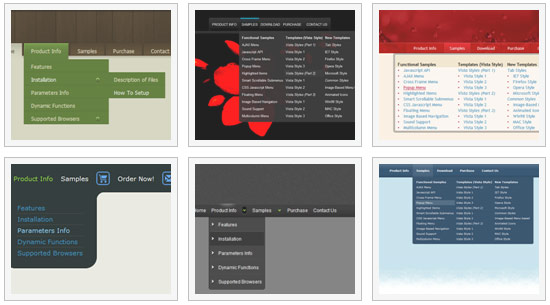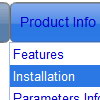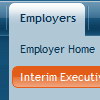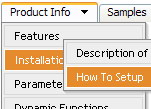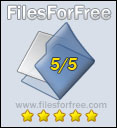Recent Questions
Q: A couple days ago I purchased the multi-website license of Deluxe Menu/Tree/Tabs/Popup Window/Calendar for US$149.00
I am having a very hard time getting the popup window to do just a basic function.
All I want is to have a link that I click on the page and the dhtml menu windows pop up.
As it is, the page automatically opens the popup window on loading.
I'm not a Javascript programmer which is why I purchased your product as it seemed I could pick a couple basic values in the GUI and it would create the script and code for me.
It would be REALLY handy if you had a couple of examples of how to create the following:
- Open the popup window upon the page loading
- Open the popup window when the user clicks a link
- Open the popup window when the user mouses over a link
- Close the popup window when the user mouses out
The help section doesn't even provide a menu item for the popup window.
Finding support for it on your site is difficult and what I can find is better suited for someone with Javascript knowledge.
Is there any way you can provide me the code to do this?
Thanks very much for your time and assistance.
A: We have such example on our website:
> - Open the popup dhtml menu windows upon the page loading
To open the popup window upon the page loading you should set thefollowing parameter:
openAfter=0
deluxePopupWindow.attachToEvent(win,'openAfter=0,,,,,')
You can find this parameter in Deluxe Tuner. See on-load.zip example.
> - Open the popup window when the user clicks a link
Create the popup window in Deluxe Tuner and save it as html. UseonClick event for a link.
See how you should write your link:
<a class="sampleLink" title="Click to open sample" href="javascript:;" onclick="deluxePopupWindow.open('win', '<DIV style=\'PADDING-RIGHT: 10px; PADDING-LEFT: 10px; PADDING-BOTTOM: 10px; COLOR: #d33a3a; PADDING-TOP: 10px; TEXT-ALIGN: center\'><B>Sample content</B></DIV><DIV style=\'font: 13px;text-align: center; color:#666666; \'><EM>This is a simple HTML code for content. Here you may also set link to content page or ID of some element.</EM>', 'Safari Style', 'width=250,height=100,resizable,scrollbars,minimizable,fullscreen,middle,right,fade-effect,opacity=1,floatable=yes', 'windows_safari')"><b>this link</b></a> opens a medium-sized dhtml floating window.
where (see on-click.js file)
'win' - is winID
'<DIV style=\'PADDING-RIGHT: 10px; PADDING-LEFT: 10px; PADDING-BOTTOM:
10px; COLOR: #d33a3a; PADDING-TOP: 10px; TEXT-ALIGN:center\'>
<B>Sample content</B></DIV><DIV style=\'font:
13px;text-align: center; color:#666666; \'><EM>This is a
simple HTML code for content. Here you may also set link to
content page or ID of some element.</EM>' - content of your
popup window
'Safari Style' - window title
'width=250,height=100,resizable,scrollbars,minimizable,fullscreen,middle,right,fade-effect,opacity=1,floatable=yes' - parameters of the popup window'windows_safari' - window skin
You can find more info about deluxePopupWindow.open function here:
http://deluxepopupwindow.com/window-installation-info.html
Notice that you shouldn't set openAfter parameter in on-click.jsfile:
deluxePopupWindow.attachToEvent(win,',,,,,')
> - Open the popup window when the user mouses over a link
> - Close the popup window when the user mouses out
You should create such popup in the same way as in the previous point,but use onMouseOver/onMouseOut events.
<a class="sampleLink" title="Click to open sample" href="javascript:;" onMouseOver="deluxePopupWindow.open('win', '<DIV style=\'PADDING-RIGHT: 10px; PADDING-LEFT: 10px; PADDING-BOTTOM: 10px; COLOR: #d33a3a; PADDING-TOP: 10px; TEXT-ALIGN: center\'><B>Sample content</B></DIV><DIV style=\'font: 13px;text-align: center; color:#666666; \'><EM>This is a simple HTML code for content. Here you may also set link to content page or ID of some element.</EM>', 'Safari Style', 'width=250,height=100,resizable,scrollbars,minimizable,fullscreen,middle,right,fade-effect,opacity=1,floatable=yes', 'windows_safari')"><b>this link</b></a> opens a medium-sized dhtml floating window.
<a class="sampleLink" title="Click to open sample" href="javascript:;" onMouseOut="deluxePopupWindow.open('win', '<DIV style=\'PADDING-RIGHT: 10px; PADDING-LEFT: 10px; PADDING-BOTTOM: 10px; COLOR: #d33a3a; PADDING-TOP: 10px; TEXT-ALIGN: center\'><B>Sample content</B></DIV><DIV style=\'font: 13px;text-align: center; color:#666666; \'><EM>This is a simple HTML code for content. Here you may also set link to content page or ID of some element.</EM>', 'Safari Style', 'width=250,height=100,resizable,scrollbars,minimizable,fullscreen,bottom,left,fade-effect,opacity=1,floatable=yes', 'windows_safari')"><b>Open popup window</b></a>
Q: Can your free dhtml menu have boarderes around the sub-menus only..
A: You should create Individual style and assign it to the first item in each submenu.
var menuStyles = [
["menuBorderWidth=1","menuBorderStyle=solid","menuBorderColor=#813A07"],
];
var menuItems = [
["Home","testlink.html", "", "", "", "", "", "", "", ],
["Product Info","", "border-example.files/icon1.gif", "border-example.files/icon1o.gif", "", "", "", "", "", ],
["|Features","testlink.html", "border-example.files/icon2.gif", "border-example.files/icon2o.gif", "", "", "", "0", "", ],
Q: We are using the javascript drop down menu code to create an external link. The absolute path is recognised but it does not work. At the bottom of the page the browser displays an "error on page" message and nothing happens.
A: Now you have
<script type="text/javascript"> var dmWorkPath = "wdmenu.files/";</script>
<script type="text/javascript" src="wdmenu.files/dmenu.js"></script>
<script type="text/javascript"> var dmWorkPath="wdtabs.files/";</script>
<script type="text/javascript" src="wdtabs.files/wdtabs.js"></script>
The second call for dmWorkPath is incorrect. Delete it. So you'llhave:
<script type="text/javascript"> var dmWorkPath = "wdmenu.files/";</script>
<script type="text/javascript" src="wdmenu.files/dmenu.js"></script>
<script type="text/javascript" src="wdtabs.files/wdtabs.js"></script>
Your menu will work correctly.
Q: I recently purchased your Deluxe-Tabs product and I am trying to create tabs that occupy 100% width with each tab being equal width.
Right now when I specify 100% menu width all of the tabs are difference sizes (widths).
How do I control the individual tab width?
A: You should use Individual Item styles to achieve this effect.
See the attached example.
You should set:
var bmenuWidth="100%";
I have 5 items in my example, so I've created Individual Style
var bstyles = [
["bitemWidth=20%"],
];
And assign it for all items:
["Item 1 aaaaa ssssss","", "", "", "", "", "0", "", "", ],
["Item 2 ffff jjjjjjjjjj","", "", "", "", "", "0", "", "", ],
["Item 3 text text","", "", "", "", "", "0", "", "", ],
["Item 4 text text","", "", "", "", "", "0", "", "", ],
["Item 5 text text","", "", "", "", "", "0", "", "", ],
But notice that items width cannot be smaller than the width of its'text. So it is possible that you'll have different size of some itemsif your window have a small size.





